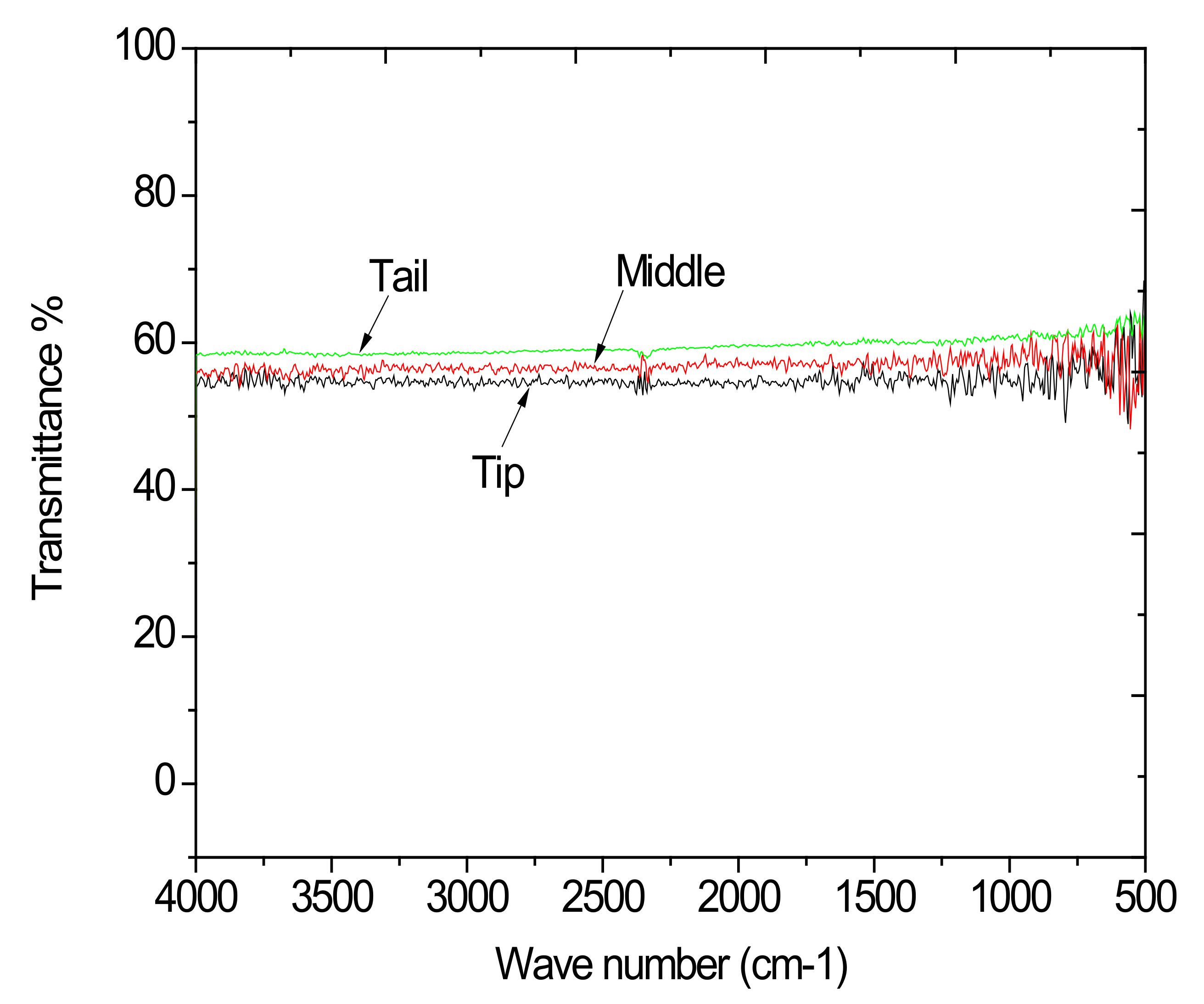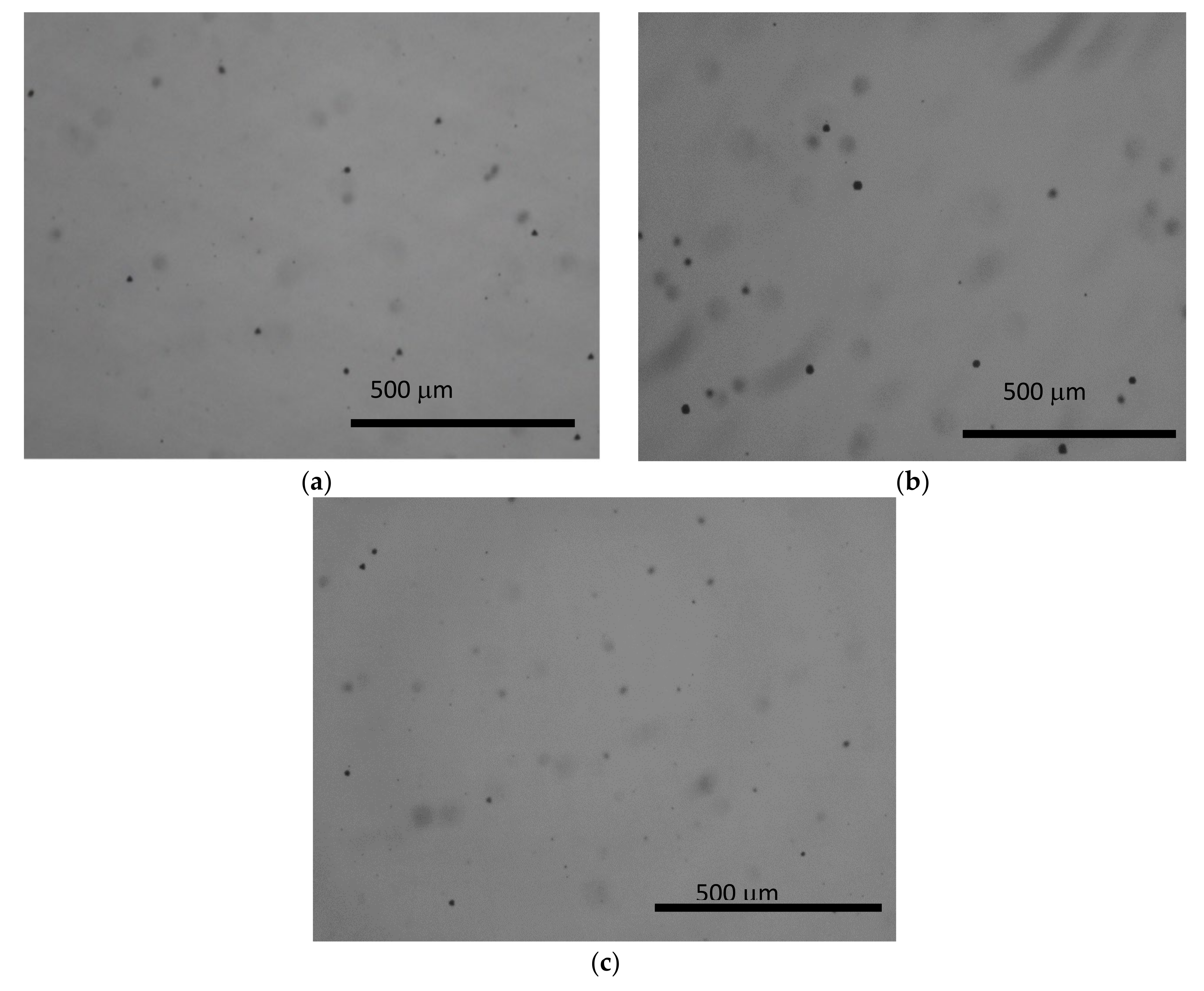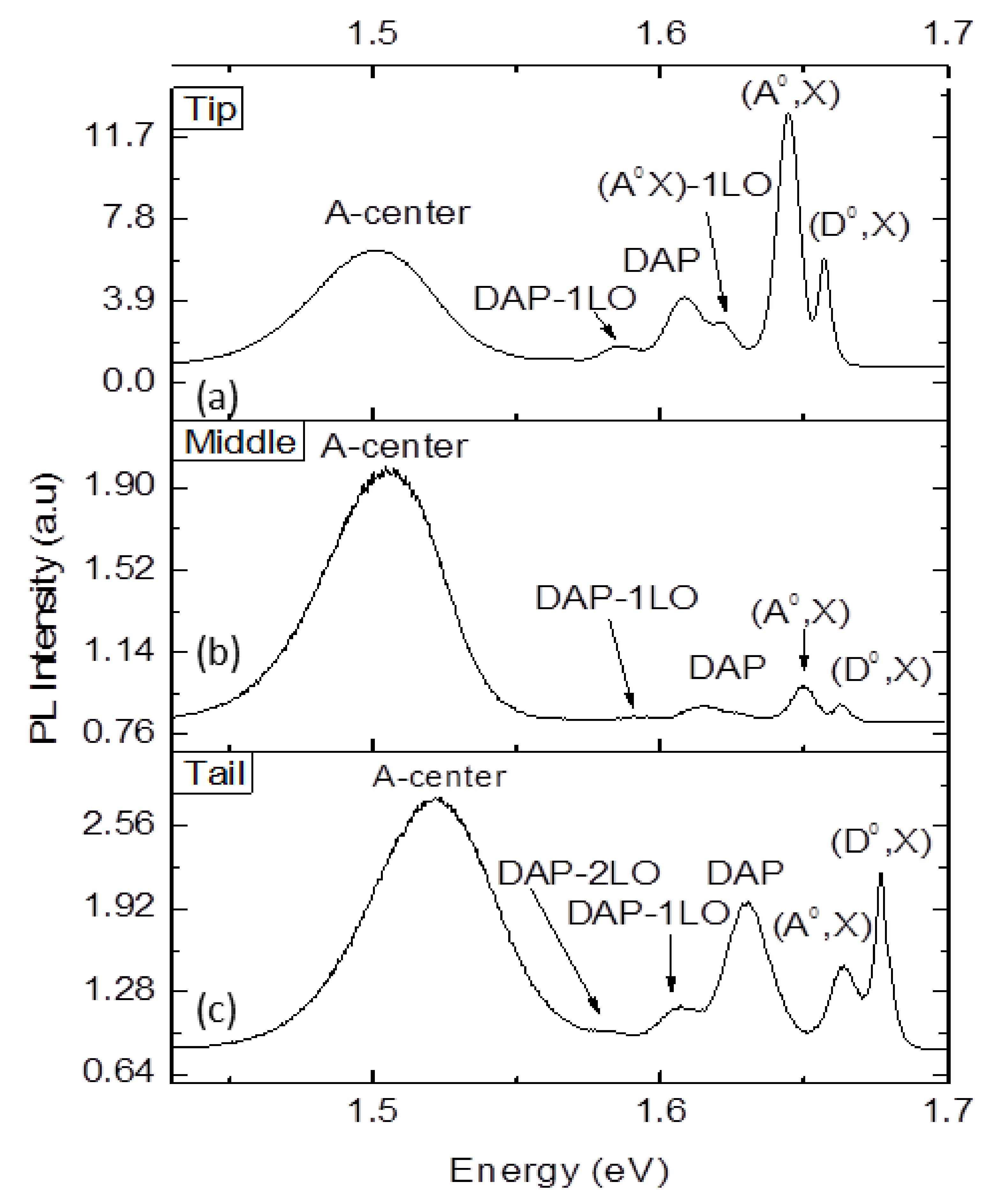Electrical and Optical Properties of Indium and Lead Co-Doped Cd0.9Zn0.1Te
Abstract
:1. Introduction
2. Materials and Methods
3. Results
3.1. Electrical Properties of Co-Doped CdZnTe:(In,Pb)
3.2. IR Transmittance
3.3. IR Microscopy
3.4. PL Measurements of Co-Doped (CZT:In,Pb)
4. Conclusions
Author Contributions
Funding
Institutional Review Board Statement
Informed Consent Statement
Data Availability Statement
Acknowledgments
Conflicts of Interest
References
- Schlesinger, T.; Toney, J.; Yoon, H.; Lee, E.; Brunett, B.; Franks, L.; James, R. Cadmium zinc telluride and its use as a nuclear radiation detector material. Mater. Sci. Eng. R Rep. 2001, 32, 103–189. [Google Scholar] [CrossRef]
- Fiederle, M.; Feltgen, T.; Meinhardt, J.; Rogalla, M.; Benz, K. State of the art of (Cd,Zn)Te as gamma detector. J. Cryst. Growth 1999, 197, 635–640. [Google Scholar] [CrossRef]
- Eisen, Y.; Shor, A. CdTe and CdZnTe materials for room-temperature X-ray and gamma ray detectors. J. Cryst. Growth 1998, 184–185, 1302–1312. [Google Scholar] [CrossRef]
- Verger, L.; Bonnefoy, J.P.; Glasser, F.; Ouvrier-Buffet, P. New developments in CdTe and CdZnTe detectors for X and γ-ray applications. J. Electron. Mater. 1997, 26, 738–744. [Google Scholar] [CrossRef]
- Limousin, O. New trends in CdTe and CdZnTe detectors for X- and gamma-ray applications. Nucl. Instrum. Methods Phys. Res. 2003, 504, 24–37. [Google Scholar] [CrossRef]
- Li, Q.; Jie, W.; Fu, L.; Wang, T.; Yang, G.; Bai, X.; Zha, G. Optical and electrical properties of indium-doped Cd0.9Zn0.1Te crystal. J. Cryst. Growth 2006, 295, 124–128. [Google Scholar] [CrossRef]
- Takahashi, T.; Watanabe, S. Recent progress in CdTe and CdZnTe detectors. IEEE Trans. Nucl. Sci. 2001, 48, 950–959. [Google Scholar] [CrossRef] [Green Version]
- Nemirovsky, Y.; Asa, G.; Gorelik, J.; Peyser, A. Spectroscopic Evaluation of n-Type CdZnTe Gamma-Ray Spectrometers. J. Electron. Mater. 2000, 6, 691–698. [Google Scholar] [CrossRef]
- Suh, J.H.; Cho, S.H.; Won, J.H.; Hong, J.K.; Kim, S.U.; Kim, K.H.; Kim, S.S. Doping effects of lead on CdZnTe crystals. J. Korean Phys. Soc. 2006, 49, 750–754. [Google Scholar]
- Li, G.; Jie, W.; Hua, H.; Gu, Z. Cd1−xZnxTe: Growth and characterization of crystals for X-ray and gamma-ray detectors. Prog. Cryst. Growth Charact. Mater. 2003, 46, 85–104. [Google Scholar] [CrossRef]
- Wang, C.; Min, J.; Zhou, C.; Liang, X.; Zhao, Y.; Wang, L.; Xia, Y. Analysis of In and Al doped high resistivity CdZnTe crystal. Phys. Status Solidi C 2010, 6, 1498–1500. [Google Scholar] [CrossRef]
- Singha, A.; Dhar, P.; Roy, A. A nondestructive tool for nanomaterials: Raman and photoluminescence spectroscopy. Am. J. Phys. 2005, 73, 224–233. [Google Scholar] [CrossRef] [Green Version]
- Zaman, Y.; Jie, W.; Wang, T.; He, Y.; Xu, L.; Guo, R.; Xu, Y.; Zha, G. Characterization of CdZnTe co-doped with indium and lead. Nucl. Instrum. Methods Phys. Res. Sect. A Accel. Spectrometers Detect. Assoc. Equip. 2015, 770, 48–51. [Google Scholar] [CrossRef]
- Grill, R.; Franc, J.; Höschl, P.; Turkevych, I.; Belas, E.; Moravec, P. Semi-Insulating Te-Saturated CdTe. IEEE Trans. Nucl. Sci. 2005, 52, 1925–1931. [Google Scholar] [CrossRef]
- Liu, J.; Mandal, K.C.; Koley, G. Investigation of nanoscale electronic properties of CdZnTe crystals by scanning spreading resistance microscopy. Semicond. Sci. Technol. 2009, 24, 45012. [Google Scholar] [CrossRef]
- Maxey, C.; Gower, J.; Capper, P.; O’Keefe, E.; Skauli, T.; Ard, C. Zn concentration determination in CdZnTe by NIR spectroscopy. J. Cryst. Growth 1999, 197, 427–434. [Google Scholar] [CrossRef]
- Ivanov, V.; Alekseeva, L.; Dorogov, P.; Loutchanski, A. Correlation between quality of CZT crystals and spectrometric performance of hemispherical radiation detectors. In Proceedings of the IEEE Symposium on Nuclear Science (NSS/MIC), Rome, Italy, 16–22 October 2004. [Google Scholar]
- Xu, Y.D.; Jie, W.Q.; He, Y.H.; Guo, R.R.; Tao, W.A.N.G.; Zha, G.Q. Size and distribution of the inclusions in detector-grade CdZnTe ingots Progress in Natural Science. Mater. Int. 2011, 21, 66–72. [Google Scholar]
- Toney, J.; Brunett, B.; Schlesinger, T.; Van Scyoc, J.; James, R.; Schieber, M.; Goorsky, M.; Yoon, H.; Eissler, E.; Johnson, C. Uniformity of Cd1—xZnxTe grown by high-pressure Bridgman. Nucl. Instrum. Methods Phys. Res. Sect. A Accel. Spectrometers Detect. Assoc. Equip. 1996, 380, 132–135. [Google Scholar] [CrossRef]
- Chen, H.; Tong, J.; Hu, Z.; Shi, D.T.; Wu, G.H.; Chen, K.T.; George, M.A.; Collins, W.E.; Burger, A.; James, R.B.; et al. Low-temperature photoluminescence of detector grade Cd1−x Zn x Te crystal treated by different chemical etch-ants. J. Appl. Phys. 1996, 80, 3509–3512. [Google Scholar] [CrossRef]




| Sample Names | Conductivity Type (N or P) | Hall Mobility (cm2/V·S) | Carrier Conc. (cm−3) | Resistivity (Ω·cm) |
|---|---|---|---|---|
| Tip | N | 9.24 × 102 cm2/V·S | 6.45 × 107 cm−3 | 1.8 × 1010 Ω·cm |
| Middle | N | 11.88 × 102 cm2/V·S | 6.8 × 109 cm−3 | 1.21 × 109 Ω·cm |
| Tail | P | 13.7 cm2/V·S | 6.78 × 108 cm−3 | 1.2 × 1010 Ω·cm |
Publisher’s Note: MDPI stays neutral with regard to jurisdictional claims in published maps and institutional affiliations. |
© 2021 by the authors. Licensee MDPI, Basel, Switzerland. This article is an open access article distributed under the terms and conditions of the Creative Commons Attribution (CC BY) license (https://creativecommons.org/licenses/by/4.0/).
Share and Cite
Zaman, Y.; Tirth, V.; Rahman, N.; Ali, A.; Khan, R.; Algahtani, A.; Irshad, K.; Islam, S.; Wang, T. Electrical and Optical Properties of Indium and Lead Co-Doped Cd0.9Zn0.1Te. Materials 2021, 14, 5825. https://doi.org/10.3390/ma14195825
Zaman Y, Tirth V, Rahman N, Ali A, Khan R, Algahtani A, Irshad K, Islam S, Wang T. Electrical and Optical Properties of Indium and Lead Co-Doped Cd0.9Zn0.1Te. Materials. 2021; 14(19):5825. https://doi.org/10.3390/ma14195825
Chicago/Turabian StyleZaman, Yasir, Vineet Tirth, Nasir Rahman, Amjad Ali, Rajwali Khan, Ali Algahtani, Kashif Irshad, Saiful Islam, and Tao Wang. 2021. "Electrical and Optical Properties of Indium and Lead Co-Doped Cd0.9Zn0.1Te" Materials 14, no. 19: 5825. https://doi.org/10.3390/ma14195825
APA StyleZaman, Y., Tirth, V., Rahman, N., Ali, A., Khan, R., Algahtani, A., Irshad, K., Islam, S., & Wang, T. (2021). Electrical and Optical Properties of Indium and Lead Co-Doped Cd0.9Zn0.1Te. Materials, 14(19), 5825. https://doi.org/10.3390/ma14195825








